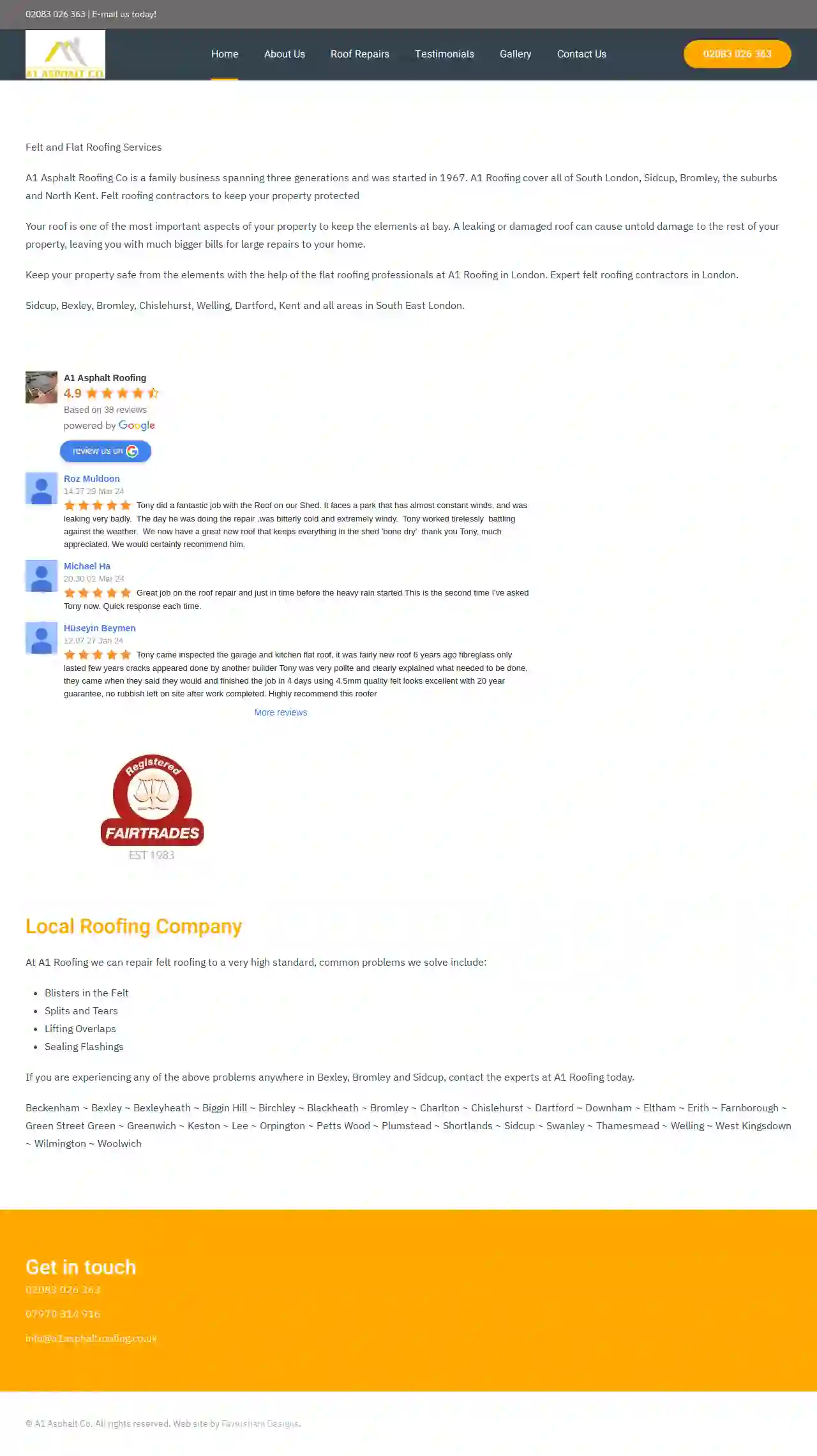Roofing Companies Dagenham
Find Roofing Companies in Dagenham
Get multiple Roofing Services quotes for your project today! Compare profiles, reviews, accreditations, portfolio, etc... and choose the best service.

Webb roofing & construction uk
Hornchurch, Essex, RM11, GBWebb Roofing & Construction is a professional construction company dedicated to delivering high-quality results using the best materials. Our team of skilled professionals is committed to providing reliable work ethics and consistent outcomes for every project. We believe in building a strong foundation for every project, ensuring its longevity and durability. Whether you need home improvement services or commercial construction, Webb Roofing & Construction is your trusted partner. Our experienced professionals handle each project with meticulous detail and care, ensuring your vision is brought to life. We offer a wide range range of services, including roofing, home demolition, bricklaying, drywalling, and carpentry. At Webb Roofing & Construction, we understand the importance of choosing a reliable and affordable company. We strive to exceed your expectations by providing exceptional customer service, clear communication, and competitive pricing. Contact us today to discuss your project needs and let us build your dream.
- Services
- Why Us?
- Gallery
Get Quote
Inspire Contract Services Ltd
Camburgh House, 27 New Dover Road, Canterbury, Kent, CT1 3DN, GBWelcome to Inspire Contract Services Ltd, a specialist roofing and building contractor founded by Gary Slawson in 2016. Since its inauguration, Inspire has grown into one of the leading specialist refurbishment contractors, developing its extensive knowledge of the commercial roofing market and expanding its building refurbishment service offering. With strong organic growth and evolution, Inspire has moved beyond simply installing roofs and is now proud to offer an all-round quality refurbishment service to both public and private sector clients.
- Services
- Why Us?
- Accreditations
- Our Team
- Testimonials
- Gallery
Get Quote
Kudos Roofing
4.934 reviews41 Avenue Road, Farnborough, GU14 7BJ, GBWelcome to Kudos Roofing. We cover all aspects of roofing work, from missing tiles, leaking flat-roofs and simple repairs, to complete re-roofs, strip and re-tile, slate and flat roof renewals. Also chimney repairs, fascias, soffits, guttering and lead work. Roofing carpentry and framing work, loft conversions, dormer windows, velux windows, flat to pitch roof conversions together with an in-house scaffolding service. Kudos Roofing services operate mainly throughout the areas of Farnborough, Aldershot, Fleet, Hartley Wintney, Frimley, Camberley, Chobham, Slough, Woking, Pirbright, Farnham, Yateley, Hook, Reading, Basingstoke and Guildford but also beyond the Hampshire, Surrey and Berkshire borders. Kudos Roofing are specialists in all pitched and flat roofs and PVCu roofline fascias, soffits, guttering and cladding. Please contact us for further information or contact us with our online enquiry form. Please do not hesitate to contact us for any enquires or discussion of your requirements. We are only too happy to help. Call us now on 07973 193248. We are a small family business, and have been trading for over 25 years. We pride ourselves on our quality of work, service and level of professionalism. We will always respond promptly to all enquires and work with the customer's needs and requirements. We deal with all aspects of roofing works including both domestic and commercial.
- Services
- Why Us?
- Gallery
Get Quote
McCormick Flat Roofing
34 reviews20 Freeman Way, Hornchurch, RM11 3PH, GBMcCormick Flat Roofing Limited is a London-based flat roofing specialist and maintenance contractor. We offer a complete range of services, including Felt Roofing, Single Ply Membrane, Asphalt, Roof Tiling, Slating and all aspects of Leadwork. Together with our complete build, repair and maintenance roofing service, we always ensure the correct technical specifications and safety requirements meet your needs. We are committed to ensuring your Roofing Project is completed on time and to your full satisfaction. Our address is: Cambridge Court, Sussex Gardens, Paddington, London You can reach us at: 01708 620 390
- Services
- Why Us?
- Gallery
Get Quote
RGS Roofing Services
4.639 reviewsRomford, GBAt RGS Roofing, we’re not just about roofs; we’re about building trust, ensuring safety, and enhancing the longevity of your home. With over 27 years of expertise, RGS Roofing stands as a beacon of reliability and quality in the roofing industry. Our commitment to delivering outstanding roofing solutions, including our specialist E.P.D.M flat roofing, has protected thousands of homes against Britain’s unpredictable weather. RGS Roofing in Hornchurch, Essex, and beyond. As a family-operated business, we blend traditional craftsmanship with cutting-edge solutions to safeguard your home. Our expertise in E.P.D.M roofing and a suite of other services is designed to offer you peace of mind under any sky.
- Services
- Why Us?
- Testimonials
- Gallery
Get Quote
A1 Asphalt Roofing
4.937 reviews29 Halfway Street, Sidcup, DA15 8LQ, GBA1 Asphalt Roofing is a family business spanning three generations and was started in 1967. A1 Roofing cover all of South London, Sidcup, Bromley, the suburbs and North Kent. Felt roofing contractors to keep your property protected. Your roof is one of the most important aspects of your property to keep the elements at bay. A leaking or damaged roof can cause untold damage to the rest of your property, leaving you with much bigger bills for large repairs to your home. Keep your property safe from the elements with the help of the flat roofing professionals at A1 Roofing in London. Expert felt roofing contractors in London. Sidcup, Bexley, Bromley, Chislehurst, Welling, Dartford, Kent and all areas in South East London.
- Services
- Why Us?
- Accreditations
- Our Team
- Testimonials
- Gallery
Get Quote
Abbey Met Supplies Ltd
53 reviewsUnit 10, The Sidcup Industrial Estate, Sidcup, BR8 1AA, GBRay, Charlie and Harry Dix are specialists stockists and distributors of Schneider Lead whom are an independent German manufacturer of Rolled Lead Sheet that has the highest quality control certification probably available to any manufacturing company (RAL), ensuring their processes are fully monitored by an independent body. The lead is CE Conformant and fully meets BS/EN12588 and is constantly checked for conformity, Abbeymet keeps in stock and on site over a 150 tonne of all codes of Lead from code 3 to code 8. From those humble beginnings in 1996 in and from a small back street shop in Orpington, Ray’s original company grew very rapidly to a larger warehouse in Orpington. Along the way it acquired another company that specialised in lead associated ancillary products, with this acquisition the companies required further expansion to even larger premises and relocated to Sidcup in 2008. In 2009 Ray passed control of his companies to a large UK lead sheet manufacturer but remained a director in a non controlling capacity and subsequently had to retire from that new company in 2013 for ethical reasons. Abbeymet was formed and managed in 2013 by members of Ray’s family, and in 2019 Ray and Charlie took ownership of Abbeymet to re create the honest success’s of Ray’s previous relationships and involvement in the lead sheet industry which spanned back to the beginning in 1996.
- Services
- Why Us?
- Our Team
- Gallery
Get Quote
CJ Roofing and Property Maintenance Ltd
4.825 reviews22 Stalisfield Place, Orpington, BR6 7HN, GBC J Roofing & Property Maintenance Ltd is a family-run roofing company with a great reputation across Kent. We work as flexibly as possible for you, the client, and can outline the materials and processes we use, work weekends if needed or even extend our hours into the evening. We pride ourselves on resolving leaks, broken gutters, damaged tiles, and all other pitched and flat roofing issues in record time. Our team also fits the latest re-roofing products for long-term coverage that continues to look great in all seasons. We lend these skills to domestic and commercial properties across Kent, defending interiors from the rain often seen in Orpington, Bromley and the surrounding areas. When it comes to roofing and property maintenance, you needn't just take our word for it. Instead, you can find us on Rated People, Trustatrader and Checkatrade, where our reviews speak for themselves. For the ultimate peace of mind, we supply 10-year guarantees for all new roofs and five-year coverage for flat roofing systems.
- Services
- Why Us?
- Accreditations
- Our Team
- Testimonials
- Gallery
Get Quote
Wills Brothers Roofing
55 reviews28 Alfred Road, Gravesend, DA11 7QF, GBWe are a small family run business with 3 generations of Roofers. We take pride and care throughout all of our work no matter what the project, our aim is to complete our work to the best standard ensuring the customer is always happy. Over the years we have built up a reputation as a reliable and affordable roofing company, our team are fully insured and complete regular training to ensure we always work to the highest standards.
- Services
- Why Us?
- Accreditations
- Our Team
- Gallery
Get Quote
Roofing RBM
4.940 reviews4217 Allan Link South West, 4217 Allan Link, Edmonton, T6W 2R1, GBRoofing RBM is a trusted company located in Edmonton, established in 2015 but with over 20 years of experience. We specialize in providing high-quality roofing, siding, and eavestroughing services to both residential and commercial clients in Edmonton and surrounding areas. Our team of highly skilled roofing experts is dedicated to delivering exceptional service and workmanship on every project. We understand the importance of a quality roof and strive to exceed our clients' expectations. We offer a bilingual service and use only the highest quality materials. We personally work on every job, treating it as if it were our own home. We never rely on other contractors who may not meet our standards of quality, honesty, and integrity. With our commitment to quality and customer satisfaction, we help our clients reduce energy costs and improve the value of their properties.
- Services
- Why Us?
- Accreditations
- Gallery
Get Quote
Over 12,314+ Roofers onboarded
Our roofing contractors operate in Dagenham and surrounding areas!
Roofyng.co.uk has curated and vetted the Best Roofers arround Dagenham. Find a reliable pro today.
Frequently Asked Questions About Roofing Companies
- Listed Buildings: Buildings with historical or architectural significance.
- Conservation Areas: Areas with special architectural or historical character.
- Changes to Roof Design: If you're making significant alterations to the roof's design, such as adding a dormer window or changing the pitch.
- Experience: Companies with a solid track record and years of experience in the industry.
- Licensing and Insurance: Verify they are properly licensed to operate in your area and carry adequate insurance to protect you from liability.
- Certifications: Look for certifications from reputable organizations, demonstrating expertise in specific roofing materials or techniques.
- Positive Reviews: Check online reviews and testimonials from previous customers.
- Professionalism: Choose a company that communicates clearly, provides detailed estimates, and has a courteous and responsive team.
- Ventilation: Soffit vents provide intake ventilation, allowing fresh air to enter the attic and regulate temperature and moisture.
- Aesthetics: It creates a finished look to the roof's underside.
- Pest Control: A properly sealed soffit prevents pests like birds and squirrels from nesting in the attic.
- Home Improvement Loans: Offered by banks or credit unions.
- Home Equity Loans or Lines of Credit: Use your home's equity as collateral.
- Government Programs: Check for energy efficiency rebates or grants.
- Contractor Financing: Some roofing companies offer financing plans.
Do I need planning permission to replace my roof in the UK?
How do I find a good roofing company?
What is a soffit, and why is it important for my roof?
How can I get financing for a new roof?
Do I need planning permission to replace my roof in the UK?
- Listed Buildings: Buildings with historical or architectural significance.
- Conservation Areas: Areas with special architectural or historical character.
- Changes to Roof Design: If you're making significant alterations to the roof's design, such as adding a dormer window or changing the pitch.
How do I find a good roofing company?
- Experience: Companies with a solid track record and years of experience in the industry.
- Licensing and Insurance: Verify they are properly licensed to operate in your area and carry adequate insurance to protect you from liability.
- Certifications: Look for certifications from reputable organizations, demonstrating expertise in specific roofing materials or techniques.
- Positive Reviews: Check online reviews and testimonials from previous customers.
- Professionalism: Choose a company that communicates clearly, provides detailed estimates, and has a courteous and responsive team.
What is a soffit, and why is it important for my roof?
- Ventilation: Soffit vents provide intake ventilation, allowing fresh air to enter the attic and regulate temperature and moisture.
- Aesthetics: It creates a finished look to the roof's underside.
- Pest Control: A properly sealed soffit prevents pests like birds and squirrels from nesting in the attic.
How can I get financing for a new roof?
- Home Improvement Loans: Offered by banks or credit unions.
- Home Equity Loans or Lines of Credit: Use your home's equity as collateral.
- Government Programs: Check for energy efficiency rebates or grants.
- Contractor Financing: Some roofing companies offer financing plans.